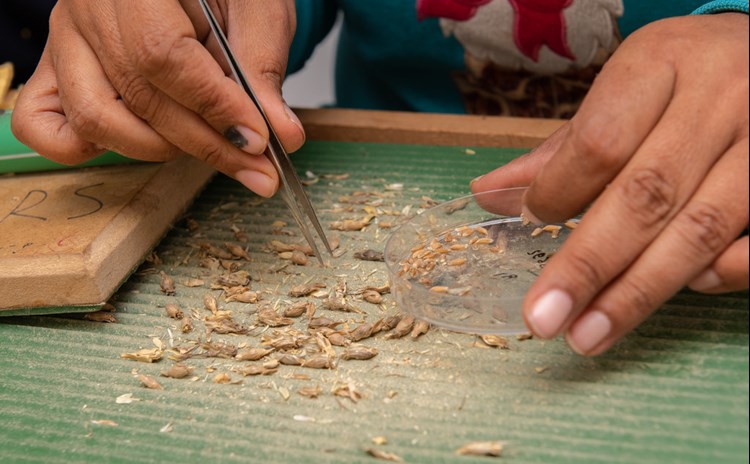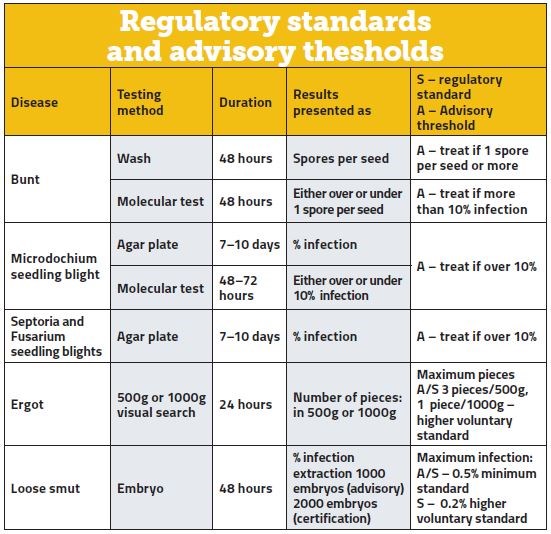Seed testing
It is a legal requirement that seed must be officially sampled and tested before it can be certified. Farm-saved seed is exempt and for that reason, it may not be sold, bartered or shared. Many farmers save seed, so it is recommended that this seed meets the minimum certified seed standards by testing for percentage germination, purity and levels of seed-borne diseases. These tests can be carried out by one of the many laboratories offering seed-testing services. The results from these tests will help you make informed decisions, reduce your costs and boost profitability and achieve high standards of seed health.
Saving seed on-farm
If you intend to save your own seed, you should observe and record the performance of the parent crop carefully, noting the field history, weed burden and performance of the crop etc. Once harvested, potential seed lots should be identified and tested.
Germination tests
These are relatively cheap tests, which will help avoid the use of poor-quality seed that will have a low rate of germination. The downside is that they can take as long as four weeks. There are two tests. The basic test is based on 200 seeds and the seeds are germinated in a controlled environment with optimum levels of light, water, temperature etc. This test distinguishes between normal and abnormal germination and dead seed. The results are given in percentage germination.
A diagnostic germination test is more expensive, but additional information is provided. Results reported as % germination, % dead seed and % abnormal seedlings, with % given for damage (dormant, heat, chemical, sprouting, disease, mechanical types)

Tetrazolium test
Where time is short, the seed viability or tetrazolium test can give results in a couple of days. This involves the use of a colourless stain, which turns red when it is taken up by living tissue. This test indicates viable tissue, but cannot detect seedling abnormalities, chemical damage or levels of disease. However, a good technician may be able to detect heat-damage, mechanical damage and sprouting. There are no standards for a tetrazolium test, so it cannot be used to certify seed. However, it is recommended that the test needs to have result of 94% or higher in order to achieve 85% germination in barley, wheat and oats (assuming no disease).
Seed vigour
This test determines the ability of the seed to perform under unfavourable conditions, so it is closest to the performance that may be achieved in the field. It can be used to determine which seed lots are suitable for storage and for selecting lots on planting value.
Common seed problems
Mechanical damage exposes the embryo, so makes the seed more vulnerable to damage, especially in dry years. Field bean is particularly susceptible to mechanical damage, although all seed can be affected. Chemical damage may be a problem in stores which have been used previously for storing other crops, especially potato, as residues of sprouting suppressant can adversely affect germination (not allowed for organic stores). A germination test will pick this up but a tetrazolium test will not. Heat damage affects all seed and is a result of drying or excessively hot weather at the time of harvesting. The germination potential of over-yeared seed will deteriorate, especially if the storage conditions were less than ideal.
Seed-borne disease
It is essential to test any untreated seed you intend to sow, whether farm-saved or certified, for seed-borne diseases, such as bunt and Microdochium seedling blight, and possibly ergot and loose smut.
Organic Seed Production
Organic certified seed must meet the same quality standards as conventionally produced seed. No conventional seed treatments should be used on organic certified or farm-saved seed. All seed considered for organic production should be tested for seed-borne diseases.

You can download a number of PDFs from the AHDB detailing information on seed storage, seed sampling and testing, plus information of the main seed-borne diseases (cereals.ahdb. org.uk)

